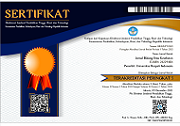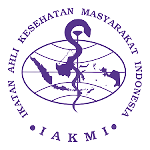Faktor yang Mempengaruhi Kejadian Demam Berdarah Dengue Berdasarkan Model Spasial di Kabupaten Sikka Tahun 2019-2021
Abstract
Keywords : Aedes Aegypti, Moran’s I, LISA, Autocorrelation spatial, Spatial regression
Keywords
Full Text:
PDFReferences
Kementerian Kesehatan) RI. Profil Kesehatan Indonesia Tahun 2019 [Internet]. Kementerian Kesehatan RI. Jakarta: Kementerian Kesehatan RI; 2020. 28–28 p. Available from: http://www.kemkes.go.id
Kementerian Kesehatan RI. Profil Kesehatan Indonesia Tahun 2017 [Internet]. Vol. 1227. 2017. 496 p. Available from: website: http://www.kemkes.go.id
Kemenkes RI. Profil Kesehatan Indonesia [Internet]. 2021. Kementrian Kesehatan Republik Indonesia. Available from: http://www.kemkes/go.id
Kurniawati R. Analisis Spasial Sebaran Kasus Demam Berdarah Dengue di Kabupaten Jember Tahun 2014 [Internet]. Universitas Jember; 2015. Available from: https://repository.unej.ac.id/handle/123456789/68807
Yandell BS, Anselin L. Spatial Econometrics: Methods and Models. Vol. 85, Journal of the American Statistical Association. 1990. 905 p.
Kurniadi A, Sutikno. Analisis Spasial Persebaran dan Pemetaan Kerawanan Kejadian Kasus Demam Berdarah Dengue di Kabupaten Lumajang dengan Spatial Pattern Analysis dan Flexibly Shaped Spatial Scan Statistic. J Sains dan Seni ITS. 2018;7(2):2337–3520.
Hernawati R, Ardiansyah MY. Analisis Pola Spasial Penyakit Demam Berdarah Dengue di Kota Bandung Menggunakan Indeks Moran. J Rekayasa Hijau. 2018;1(3):221–32.
Novratilova S, Budi AP. Analisis Sebaran Demam Berdarah Dengue (Dbd) Di Provinsi Jawa Tengah Tahun 2018. (Jurnal Ilm Mhs Kesehat Masyarakat). 2021;6(1):1–8.
Astuti SD, Rejeki DSS, Nurhayati S. Analisis Autokorelasi Spasial Kejadian Demam Berdarah Dengue ( DBD ) di Kabupaten Klaten Tahun 2020. J Vektor Penyakit. 2022;16(1):23–32.
Yuliana R, Rahmaniati M, Apriantini I, Triarjunet R. Analisis Autokorelasi Spasial Kasus Demam Berdarah Dengue di Kota Padang. J Ilmu Kesehat. 2022;6(1):34–42.
Paomey VC, Nelwan JE, Kaunang WPJ, Kesehatan F, Universitas M, Ratulangi S. Sebaran Penyakit Demam Berdarah Dengue Berdasarkan Ketinggian Dan Kepadatan Penduduk Di Kecamatan Malalayang Kota Manado Tahun 2019. Kesmas. 2019;8(6):521–7.
Wahyuningsih S. Kajian Tentang Nyamuk Aedes aegypti di Daerah Dataran Rendah dan Dataran Tinggi di Kabupaten Karanganyar Tahun 2003. 2004;3(2):46–9.
Nuryati E, Thamrin. Analisis Spasial Kejadian Demam Berdarah Dengue Di Kota Bandar Lampung Tahun 2006-2008. J Ilmu Kesehat. 2012;1(2):1–15.
Sihombing, Gustina Fajarwati IM. Hubungan Curah Hujan, Suhu Udara, Kelembaban Udara, Kepadatan Penduduk dan Luas Lahan Pemukiman Dengan Kejadian Demam Berdarah Dengue Di Kota Batam Periode Tahun 2002-2011. Lingkung dan Keselam Kerja [Internet]. 2014;3(1). Available from: https://media.neliti.com/media/publications/14459-ID-hubungan-curah-hujan-suhu-udara-kelembaban-udara-kepadatan-penduduk-dan-luas-lah.pdf
Jum Dewi Sartika, Hasanuddin Ishak D. Hubungan Curah Hujan, Kepadatan Penduduk Dan Perilaku Dengan Kejadian Dbd Di Wilayah Kabupaten Maros. Kesehat Masy. 2015;
Agcrista Permata Kusuma DMS. Analisis Spasial Kejadian Demam Berdarah Dengue Berdasarkan Kepadatan Penduduk. Unnes J Public Heal [Internet]. 2015;3(1):1–10. Available from: http://journal.unnes.ac.id/sju/index.php/ujph%0A
Tamengkel HV, Sumampouw OJ, Pinontoan OR. Ketinggian Tempat Dan Kejadian Demam Berdarah Dengue. Indones J Public Heal Community Med. 2020;1(1):12–8.
Chandra E. Pengaruh Faktor Iklim, Kepadatan Penduduk dan Angka Bebas Jentik (ABJ) Terhadap Kejadian Demam Berdarah Dengue (DBD) di Kota Jambi. J Pembang Berkelanjutan. 2019;1(1):1–15.
Ridha MR, Indriyati L, Tomia A, Juhairiyah. Pengaruh Iklim Terhadap Kejadian Demam Berdarah Dengue di Kota Ternate. Spirakel. 2019;11(2):53–62.
DOI: https://doi.org/10.52643/jbik.v13i3.2636
Refbacks
- There are currently no refbacks.
Copyright (c) 2023 Jurnal Bidang Ilmu Kesehatan













